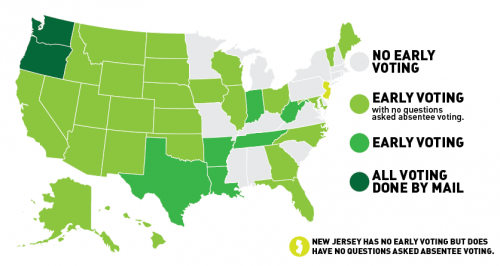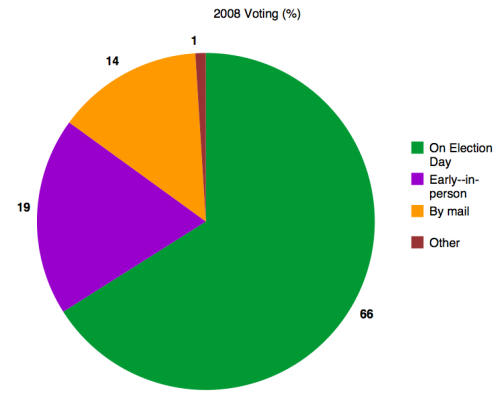Today’s the big day: it’s Election Day in the U.S. This is the day we all go out and select our president.
Sort of. The first Tuesday in November is set as the official day to go to the polls. But many states now allow early voting and/or place few restrictions on absentee voting. ThinkProgress created a map illustrating the availability of early voting:
In Nevada, early voting began October 20th. All registered voters receive a schedule of early voting locations; some are open every day, while additional locations open on weekends.
I voted at a grocery store on the afternoon of the 20th. I was surprised there was a line. A poll worker said they expected more than a thousand people would vote in that location on that day alone, up from about 800 the first day of voting in 2008.
The appeal of early voting is pretty obvious: more time to do it, a greater likelihood that you can vote without having to take off of work, spreading voting out over time means shorter lines and less waiting to cast your vote, convenient locations, and also when a pollster calls and you tell them you already voted, sometimes you get to skip a lot of their questions.
So how many people take advantage of early voting? The Pew Research Center released some data about the 2008 election. A third of voters said they voted early, either in person or by mail:
That’s a third of all voters — but a number of states, especially on the East Coast, don’t offer early voting. In the South, 42% of voters had cast their ballots before Election Day, according to the full report.
Early voting is expected to be more common this year than in 2008. For instance, 56% of all registered voters in Nevada, one of the coveted swing states, went to the polls before early voting ended on Saturday. That will likely be 65-70% of the total turnout.
Voters’ behavior indicates a clear preference for early voting. It can address at least some of the reasons given by those who are registered but do not vote as obstacles to their participation, especially if voting by mail is an option.
We still focus on Election Day as the day, because it’s the end of the election cycle and, for many voters, still their only option for voting (and we may see a shift back in this direction, as states like Florida have restricted early voting). But in some of the all-important swing states that make or break a candidate’s bid for the presidency, the outcome of the election has already been decided; Election Day just determines the margin of victory.
Gwen Sharp is an associate professor of sociology at Nevada State College. You can follow her on Twitter at @gwensharpnv.


Comments 11
LynneSkysong — November 6, 2012
I voted about a week ago via absentee ballot that filled and mailed out. I'd probably be able to vote on election day, but I wanted to be able to take my time and research each of the candidates and issues. I knew who I would vote for president, but there were many, many more local issues (that are likely to effect me much more) that I knew little about. I live in Ohio and for a while i wasn't sure how long the polls near me would be open. The was talk about mostly democratic polls being shutdown earlier and while I don't think that'll happen, it was a possibly at some point. I was also shocked to hear that absentee ballot voting wasn't an option for all voters. I don't understand why so many states have restrictions on what is a simple process in Ohio.
Renee — November 6, 2012
Election Day is not actually the first Tuesday in November; it is the first Tuesday after the first Monday in November. If November 1 falls on a Tuesday, as it did last year, then Election Day is November 8.
I make calendars each year on Apple's iPhoto system, and the calendar comes pre-populated with major holidays. In 2011, they marked November 1 as Election Day; when the geniuses realized that they got it wrong, they decided that Election Day must be the second Tuesday in November, so the 2012 calendar has Election Day on November 13.
What Time Do the Polls Close, Whos Winning the Election, and Everything You Should Read on Election Day | Egypt — November 6, 2012
[...] [...]
THE DECREASING SIGNIFICANCE OF ELECTION DAY | Welcome to the Doctor's Office — November 6, 2012
[...] from SocImages [...]
ahimsa — November 6, 2012
Here's a minor correction about voting in Oregon and Washington. The map legend says "all voting done by mail" for these two states. I'm sure it was not meant to be misleading but that wording is not quite right. It makes it sound as if all voters must return their ballots by mail.
The way it works is that all ballots are sent to voters by mail a couple of weeks before the election. But voters need not return the ballots in the same way. They can either return ballots by mail or drop them off in person at an official drop site.
In Oregon, all ballots must be received by 8 PM on election day. I believe that quite a few people will be dropping off their ballots today at the official drop off locations. This article (see http://wordpress.reed.edu/earlyvoting/commentary/the-is-little-early-early-voting-in-a-mature-early-voting-state/ ) says about 25% wait until election day to vote.
It's a small point but I thought it was worth sharing.
Tobu — November 10, 2012
Early voting seems great in that it removes some of the hassle that makes it hard to vote, but it's completely insecure to leave ballots unsupervised for days.
abra1 — November 12, 2012
In light of all the shenanigans regarding whether or not IDs were requires, voter roll purging, and challenging voters, one of the biggest potential benefits of in-person voting is that you have the opportunity to fix any problem and vote a standard rather than a provisional ballot -- you just try another day and bring the right ID, determine you don't actually need the ID, or reestablish your registration (depending on the circumstances).
Yes, not everyone who encounters though issues is going to go back but it has the potential to take some of the wind out of the voter suppression sails and gives advocates a better opportunity to document the effect of those efforts.
neha — July 23, 2021
Always excited to play my favorite robux game and if their is any issue i get help from here free v-bucks generator this tutorial teaches us how to play for free and online without download.